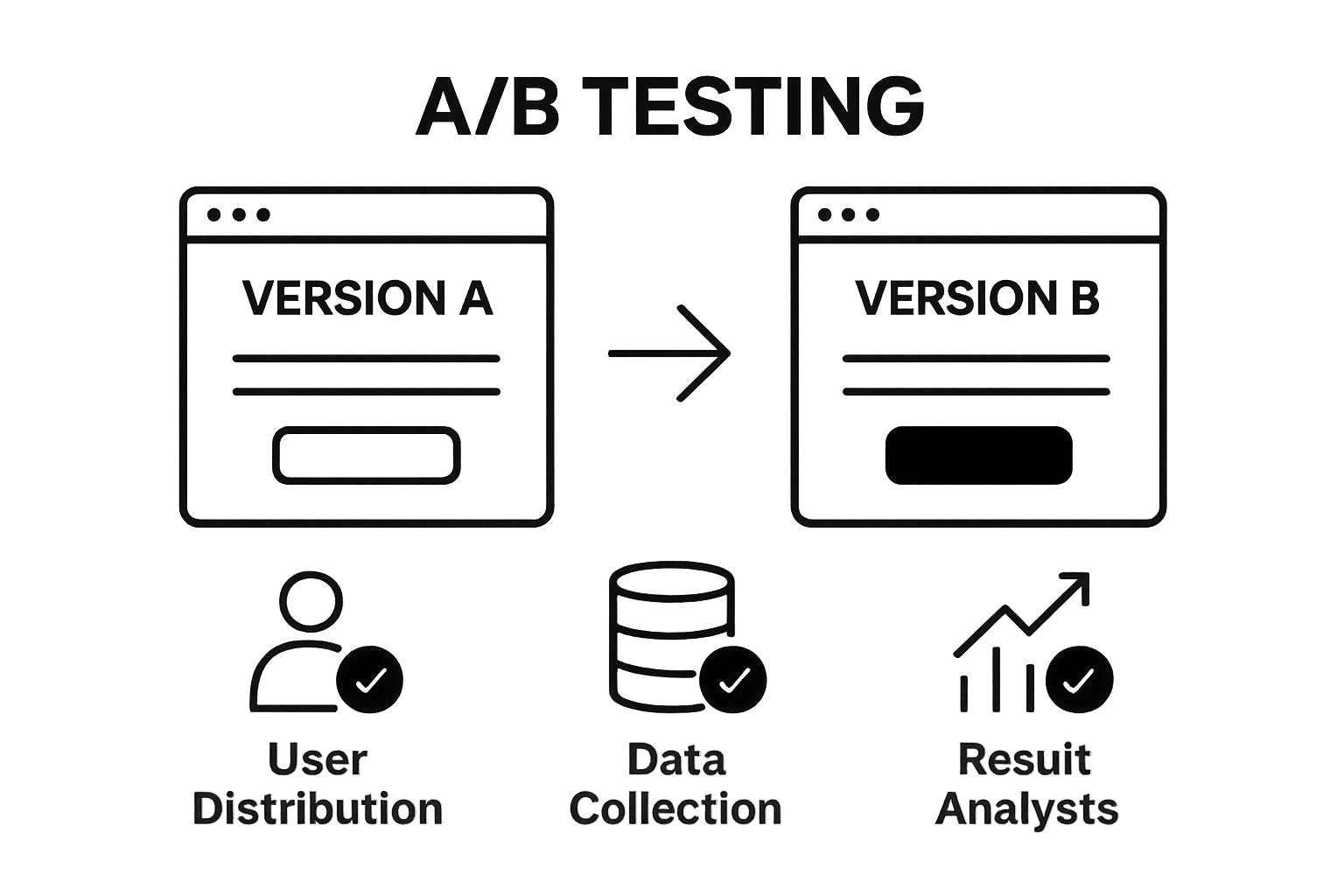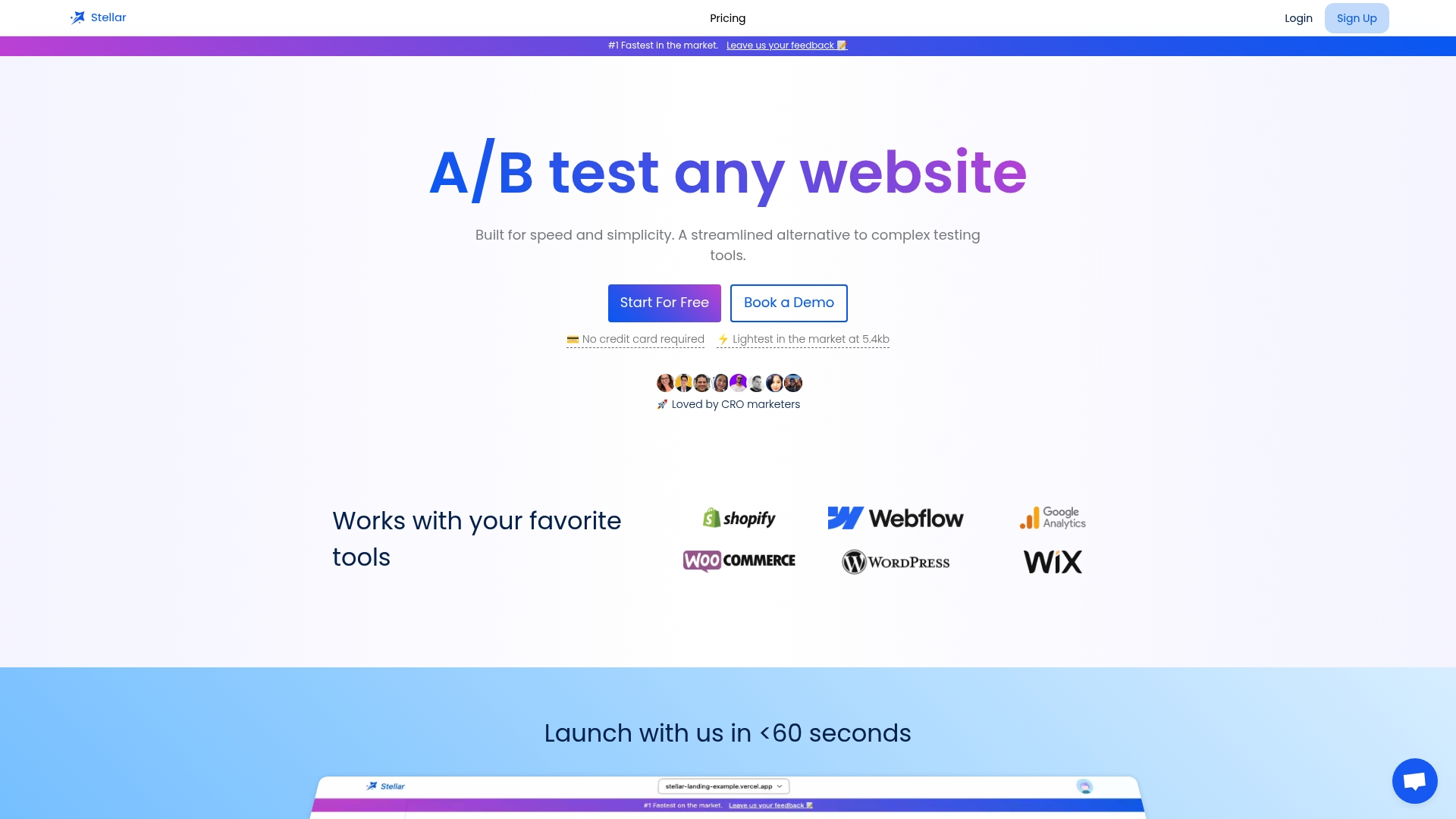
Understanding A/B Testing: Explaining A/B Testing to Teams

A/B testing is everywhere, powering the smartest decisions behind websites, apps, and ads. Over 70 percent of top-performing companies run more than 50 A/B tests each year. You might think these teams spend most of their time searching for major design overhauls. The real secret is that often, tiny changes—like a single word or a color swap—deliver the biggest wins.
Table of Contents
- What Is A/B Testing And Why It Matters
- The Importance Of A/B Testing In Marketing
- How A/B Testing Works: The Process Explained
- Key Concepts And Terminology In A/B Testing
- Real-World Examples Of A/B Testing Success
Quick Summary
| Takeaway | Explanation |
|---|---|
| A/B testing reduces guesswork | A/B testing eliminates subjective decisions by providing data-driven insights that guide strategic choices. |
| Test key marketing elements | Marketers can optimize aspects like email subject lines and landing page designs to improve performance. |
| Use statistical analysis for significance | Reliable outcomes require detailed statistical methods, focusing on confidence levels and sample sizes. |
| Understand user preferences | Insights from A/B testing reveal what resonates with target audiences, enhancing engagement and effectiveness. |
| Empower continuous optimization | The A/B testing process encourages ongoing improvements in marketing strategies based on empirical data. |
What is A/B Testing and Why It Matters
A/B testing is a powerful data-driven method that empowers teams to make strategic decisions by systematically comparing two versions of a digital asset. According to research from Harvard Business Review, A/B testing represents a critical approach for understanding user behavior and optimizing performance.
The Fundamental Concept
At its core, A/B testing involves creating two distinct versions of a webpage, email, advertisement, or user interface element. These versions labeled A and B are presented to different segments of users simultaneously. The goal is to determine which version generates superior results based on predefined metrics such as click-through rates, conversions, or engagement.

Key Components of A/B Testing:
- Version A: The original or control version
- Version B: The modified version with strategic changes
- Randomized User Distribution: Ensuring unbiased exposure
- Statistical Analysis: Measuring significant performance differences
Why A/B Testing Matters for Teams
Successful teams leverage A/B testing to eliminate guesswork and subjective decision-making. Research from Nielsen Norman Group highlights that data-driven approaches reduce risks associated with product and design modifications. By systematically testing hypotheses, organizations can make informed choices that directly impact user experience and business outcomes.
Teams benefit from A/B testing by:
- Understanding precise user preferences
- Reducing potential implementation risks
- Generating quantifiable insights
- Improving overall product performance
Learn more about data-driven insights for better conversions and how A/B testing transforms decision-making processes across digital platforms.
The Importance of A/B Testing in Marketing
Marketing professionals recognize A/B testing as a transformative strategy that enables precise performance optimization and strategic decision-making. According to research from the Content Marketing Institute, A/B testing provides critical insights that help organizations understand and improve their marketing initiatives.
Driving Marketing Performance
A/B testing enables marketers to scientifically evaluate different campaign elements, systematically comparing variations to determine which approach generates superior results. This method allows teams to move beyond intuition and make data-driven decisions that directly impact marketing effectiveness.
The following table highlights some of the most common marketing elements that teams can optimize through A/B testing, along with their potential impacts when tested.
| Marketing Element | Example Test | Potential Impact |
|---|---|---|
| Email Subject Line | \ |
Critical Marketing Elements to Test:
- Email subject lines
- Landing page designs
- Call-to-action button colors
- Advertisement headlines
- Product descriptions
- Visual imagery and graphics
Strategic Marketing Insights
Beyond immediate performance metrics, A/B testing provides deep insights into audience preferences and behaviors. By testing different variations, marketing teams can uncover nuanced understanding of what resonates with their target demographic, enabling more sophisticated and targeted communication strategies.
Marketing professionals gain substantial advantages through A/B testing, including:
- Quantifiable performance measurements
- Reduced marketing spend waste
- Enhanced audience engagement
- Continuous learning and optimization
Discover advanced strategies for running split tests and unlock your marketing team's potential for data-driven success.
How A/B Testing Works: The Process Explained
A/B testing represents a systematic approach to understanding performance variations through controlled experimentation. According to Optimizely's definitive testing methodology, the process involves strategic design, precise implementation, and rigorous statistical analysis.
Fundamental Experimental Design
The A/B testing process begins with identifying a specific element to test and formulating a clear hypothesis about potential improvements. Researchers create two versions of the asset: the control version (A) and a modified version (B) with a single strategic change. This controlled approach allows teams to isolate the impact of specific modifications.
Key Experimental Components:
- Control Version (A): Original baseline design
- Variant Version (B): Modified design with targeted changes
- Randomized User Allocation: Ensuring unbiased distribution
- Predetermined Performance Metrics: Specific goals for evaluation
Statistical Analysis and Interpretation
Successful A/B testing relies on robust statistical methods to determine whether observed differences are statistically significant or merely coincidental. Teams must establish a confidence level typically between 95% and 99%, ensuring that results are not produced by random chance.
Critical considerations during analysis include:
- Sample size sufficiency
- Duration of experiment
- Elimination of external variables
- Comprehensive performance metrics
Learn more about understanding A/B testing success rates and refine your experimental approach with advanced statistical techniques.
Key Concepts and Terminology in A/B Testing
Understanding the specialized language of A/B testing is crucial for effective implementation and interpretation of experimental results. According to statistical research from Statistics How To, mastering core terminology enables more precise and meaningful experimental analysis.
Core Statistical Foundations
A/B testing introduces several technical concepts that transform raw data into actionable insights. Statistical significance emerges as a fundamental principle, representing the likelihood that experimental results occur due to genuine differences rather than random chance.
Essential Statistical Terms:
- P-Value: Probability of obtaining results by random chance
- Confidence Interval: Range representing potential true effect magnitude
- Significance Level: Predetermined threshold for accepting experimental results
- Null Hypothesis: Assumption of no meaningful difference between variations
Experimental Performance Metrics
Professional A/B testers rely on specific performance indicators to evaluate experimental outcomes. These metrics transform abstract data into concrete insights about user behavior and design effectiveness.
Below is a table summarizing the key statistical terms used in A/B testing and their definitions, helping teams understand foundational concepts for successful experimentation.
| Term | Definition |
|---|---|
| P-Value | Probability that results occurred by random chance |
| Confidence Interval | Range representing potential true effect magnitude |
| Significance Level | Threshold for determining if results are statistically meaningful |
| Null Hypothesis | Assumption that no meaningful difference exists between the variations |
| Conversion Rate | Percentage of users who complete a desired action (e.g., purchase, sign-up) |
| Click-Through Rate | Percentage of users who click a specific link or element |
| Bounce Rate | Percentage of users who leave without further interaction |
| Revenue per Visitor | Average revenue generated by each visitor |
Key performance metrics include:

- Conversion rate
- Click-through rate
- Engagement duration
- Bounce rate
- Revenue per visitor
Explore the nuanced differences between A/B testing and split testing to enhance your experimental precision and comprehension.
Real-World Examples of A/B Testing Success
A/B testing transforms theoretical concepts into tangible business improvements across diverse industries. According to research from the National Center for Biotechnology Information, strategic experimentation yields significant performance enhancements beyond traditional digital domains.
E-commerce Conversion Optimization
Online retailers leverage A/B testing to fine-tune critical user experience elements. By systematically testing variations in product pages, checkout processes, and promotional strategies, companies can dramatically increase conversion rates and revenue.
Notable E-commerce Testing Scenarios:
- Button color modifications increasing click-through rates
- Pricing display strategies impacting purchase decisions
- Product description length and formatting
- Checkout process simplification
- Image placement and product visualization
Digital Marketing and Communication Strategies
Marketing teams utilize A/B testing to understand nuanced audience preferences. Subtle changes in email subject lines, advertisement copy, and visual design can significantly impact engagement and communication effectiveness.
Companies have achieved remarkable results through strategic testing:
- Increased email open rates
- Higher click-through percentages
- Improved audience segmentation
- More precise targeting
- Enhanced content personalization
Learn about effective onboarding A/B test campaigns to unlock advanced optimization strategies for your organization.
Turn Your A/B Testing Insights into Real Business Wins
Are you ready to move beyond theory and actually put your A/B testing knowledge to work? The article showed how teams struggle with slow testing cycles, complicated tools, and a lack of actionable analytics. Many marketers want data-driven progress but are held back by limited resources, technical hurdles, or bulky traditional platforms. Imagine a world where your experiments are painless, your results arrive in real time, and you are never slowed down by complex code or confusing dashboards.

Experience it for yourself with Stellar. Take the ideas from "Understanding A/B Testing: Explaining A/B Testing to Teams" and finally put them into practice. With our visual editor and real-time analytics, you can launch tests quickly, adapt strategies instantly, and see measurable results even if you have no technical background. Do not let uncertainty or slow decision-making stop your growth. Sign up today for a free plan and transform your team's next big idea into actual wins. Get started now and witness the difference smart, efficient experimentation makes.
Frequently Asked Questions
What is A/B testing?
A/B testing is a method used to compare two versions of a digital asset to determine which one performs better based on specific metrics like click-through rates or conversions.
Why is A/B testing important for teams?
A/B testing allows teams to make data-driven decisions, reducing guesswork and the risks associated with product and design changes, ultimately enhancing user experience and business outcomes.
What elements can be tested in marketing using A/B testing?
Marketing teams can test various elements such as email subject lines, landing page designs, call-to-action button colors, advertisement headlines, and product descriptions to optimize performance.
How do teams determine statistical significance in A/B testing results?
Teams analyze the results using statistical methods to establish confidence levels, typically between 95% and 99%, ensuring that the observed differences are not due to random chance.
Recommended
Published: 10/3/2025